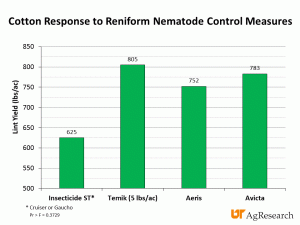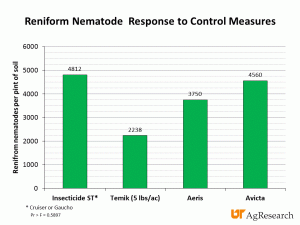Reniform nematodes (Rotylenchulus reniformis) have been found in Bedford, Crockett, Dyer, Fayette, Gibson, Hardeman, Haywood, Lincoln, Madison, Obion, and Shelby counties in Tennessee. This nematode has been a problem for cotton producers in several states. Reniform nematodes were first found in Madison and Crockett counties in the late 1990’s and are spread very easily on farm equipment. Reniform nematodes are most often associated with silty and clay soils, in contrast root-knot nematodes(Meloidogyne incognita) are typically associated with sandier soils. The only way to know if nematodes are present is to sample cotton fields in the fall immediately after cotton harvest. Reniform nematodes have been found as deep as 36 inches in the soil, making eradication impossible.
No commercial cotton varieties are resistant to reniform nematode. In contrast, some cotton varieties such as PHY 367 WRF and ST 5458B2RF have some level of tolerance to root-knot nematode. If reniform nematodes are discovered, a potential cultural method to reduce nematode numbers is to rotate cotton with a non-host crop such as corn or grain sorghum. Winter grain crops such as wheat, rye, oats and barley also are non-hosts; however, legume winter cover crops such as vetch and clover can be host plants for reniform nematode. If root-knot nematodes are present rotation is not effective and additional control measures such as using injections of Telone may be required.
Temik 15G applied at 5 lb./acre in-furrow at planting has been the standard for protection from nematodes. Bayer CropScience, the manufacturer of Temik, has stated that Temik registration will not be renewed, and that all Temik use would be phased out by 2014. Recently you have probably seen reports that Bayer has discontinued production of Temik 15G and only product that is in the supply chain will be available for 2011. Several products have been marketed recently to address nematodes from a seed treatment perspective. Aeris (thiodicarb + imidacloprid) or Poncho (clothianidin) + VOTiVO (Bacillus firmus I-1582) form Bayer CropScience and Avicta Duo (abamectin + thiomethoxam) from Syngenta are available to help control nematodes. Results presented below are from trials at a reniform nematode invested location west of Jackson from 2007-2010.
 At this location average nematode numbers were below 5000 per pint of soil and the nematicide seed treatments performed equally overall years. Over the 4 year period the only year Temik outperformed the seed treatment nematicides was 2010 where water was limited during the last third of the growing season. From peak bloom to the first open boll is when water demand is greatest and root damage from nematodes can have a more pronounced effect on yield.
At this location average nematode numbers were below 5000 per pint of soil and the nematicide seed treatments performed equally overall years. Over the 4 year period the only year Temik outperformed the seed treatment nematicides was 2010 where water was limited during the last third of the growing season. From peak bloom to the first open boll is when water demand is greatest and root damage from nematodes can have a more pronounced effect on yield.
For fields with heavy nematode infestations (above 5000 per pint of soil) the addition of an application of Vydate at pinhead square and a follow up application 14 days later will help provide additional yield protection. Typically this Vyate application can be time to help control early season plant bugs as well.
Results from these trials indicate that seed treatment nematicides can provide protection from light to moderate reniform nematode infestations. Keep in mind that these products will not be of benefit if you do not have nematodes in your fields. If you have fields where yields are decreasing each year you need to sample for nematodes. The only way to know if they are present is to sample. Please contact your local county Extension office for sampling procedures and handling. UT Extension can get your samples analyzed for $10 per sample.



One thought on “Nematode Management in Cotton”
Comments are closed.